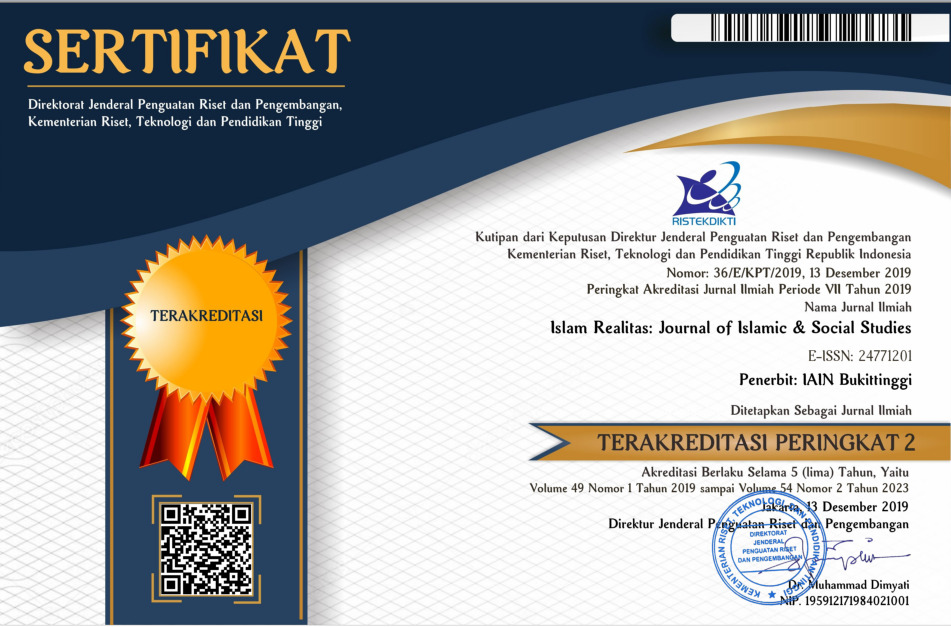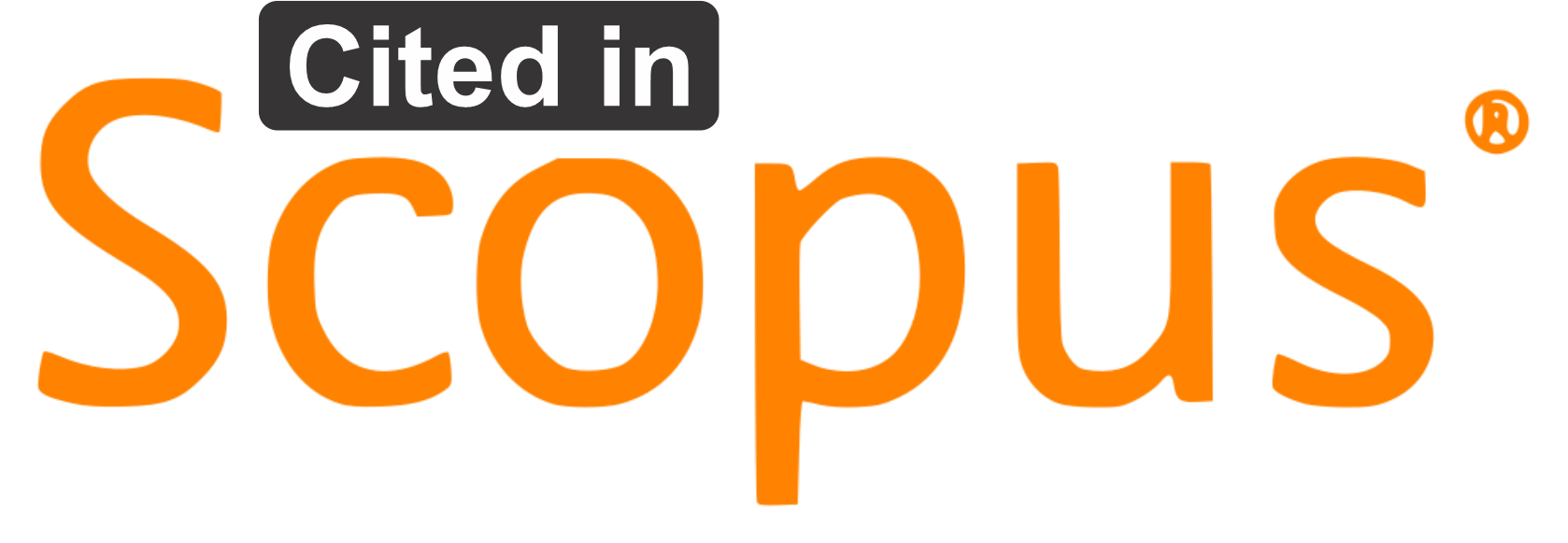FEMALE ULAMA: MEDIATING RELIGIOUS AUTHORITY IN A LIMITED ‘ISLAMIC’ PUBLIC SPHERE IN CONTEMPORARY INDONESIA
Downloads
Religious authority and the viable role played by female ulama in a limited Islamic public sphere have always been a matter of concern. Unlike previous studies focused much on gender sensitive, this research will analyze crucial position of Islamic public sphere in which female santri of Ma’had ‘Ali As’adiyah South Sulawesi can build and transform their authority. The research argues the decrease level of female authority is due to their lack of involvement in limited Islamic public sphere within and outside pesantren. Drawing on female santris’ daily activities, particular attention will be given to how female As’adiyah achieve, harness, build and transform religious authority through mosque and classroom environment. This reveals that authority of female ulama has not exclusively to do with the mastering of classical Islamic knowledge, but also with the maximizing the use of a limited ‘religious’ public sphere which is represented in halaqah of mosque, preaching stage, and the production of hybrid knowledge within classroom environment.
Abbas, Sirojuddin. Transformasi Otoritas Keagamaan, (ed) Jajat Burhanuddin dan Ahmad Baedhowi. 2003.
Agadjanian, Victor dan Scott T. Yakibu, ‘Religious Belonging, Religious Agency, and Women Autonomy in Mozambique,’ dalam Journal Science Study Religion, Volume 54, Number 3, Tahun 2015.
Agadjanian, Victor. ‘Women’s Religious Authority in a Sub-Saharan Setting: Dialectics of Empowerment and Dependency, Volume 29, Number 6, Tahun 2015.
Ali, dkk. Arshad. ‘Socio-Ethical Impact of Turkish Drama on Educated Females of Gujranwala-Pakistan,’ dalam Journal of Humanities and Social Science, Volume 20, Issue 2, Tahun 2015.
Arnez, Monika. ‘Empowering Women Trought Islam: Fatayat NU Between Tradition and Change,’ dalam Journal of Islamic Studies, Volume 21, Number 1, Tahun 2010.
Allievi, Stevano dan Jorgen Nielsen, Muslim Network and Transnational Communities in and Across Europe, Leiden: Brill, 2003.
Azra, Azyumardi. Esei-esei Intelektual Muslim dan Pendidikan Islam. Jakarta: Logos Wacana Ilmu.
-------., Jaringan Ulama Timur Tengah dan Kepulauan Nusantara Abad XVII dan XVIII: Melacak Akar-akar Pembaharuan Islam di Nusantara. Cet. I; Bandung: Mizan, 1999.
-------., Pendidikan Islam: Tradisi dan Modernisasi Menuju Millenium Baru. Jakarta: Logos Wacana Ilmu, 2002.
Baavur, Liora Hindelman. “Promises and Perlis of Weblogistan: Online Personal Journals and the Islamic Republic of Iran,†dalam MERIA: The Middle East Review of International Affairs, June 2007.
Bano, Masooda dan Hilary Kalmbach, ‘Women, Leadership and Mosque’, dalam Margot Bardan dan Valentine Moghadam, Women and Gender: The Middle East and Islamic World, Volume 11, Leiden-Boston, Brill, 2012.
Bernardi, Chiara. “Saudi Bloggers, Women Issues and NGOs, dalam Arab Media and Society, 11, 2010.
al-Bone, Abdul Aziz. Lembaga Pendidikan Islam di Sulawesi Selatan: Studi Kasus di Perguruan Tinggi As’adiyah Sengkang. Jakarta: YIIS, 1986.
Bruinessen, Marin van. ‘Indonesia’s Ulama and Politics: Caught Between Legitimising the Status Quo and Searching for Alternatives,’ dalam Prisma: the Indonesian Indicator, No. 49, Tahun 1990.
Bunt, Gary R. “Towards an Islamic Information Revolution?†dalam Muslim and the New Media, diedit oleh Elizabeth Poole and John E. Richardson. London I.B. Tauris, 2006.
-------., Islam in the Digital Age E-Jihad, Online Fatwas, and Cyber Islamic Environment, London Pluto Press, 2003.
Castells, M. The Internet Galaxy: Reflexion on the Internet, Business, and Society, New York, NY; Oxfrod University Press, 2001.
Dewi, Kurniawan Hastuti. ‘Javanese Women and Islam: Identity Formation since The Twentiwth Century,’ dalam Southeast Asian Studies, Volume 1, Nomor 1, Tahun 2012.
Djamas, Nurhayati. Dinamika Pendidikan Islam di Indonesia Pasca Kemerdekaan. Jakarta: Rajagrafindo Persada, 2009.
Eickelman Dale F. dan James Piscatory, Muslim Politics, Princeton, NJ: Princeton University Press, 1996.
Eickelmen, Dale F. and Armando Salvatore, “The Public Sphere and Muslim Identities,†European Journal of Sociology, 43:1, 2002.
El-Nawawy, Muhammed dan Sahar Khamis. “Divergent Identities in the Virtual Islamic Publich Sphere: A Case Study of the English Discussion Forum Islamonline,†dalam Journal of Arab and Muslim Media Research, 5:1. 2012.
Epley, Jennifer L. “Weber’s Theory of Charismatic Leadership: The Case of Muslim Leader in Contemporary Indonesian Politic†dalam International Journal of Humanities and Social Science, Vol. 5. No. 7. July 2015.
Esposito, John L. (ed), The Oxford Encyclopedia of the Modern Islamic World. New York-Oxford: Oxford University Press, 1995.
Fanani, Muhyar. Metode Studi Islam: Aplikasi Sosiologi Pengetahuan Sebagai Cara Pandang. Cet. II; Jakarta: Pustaka Pelajar, 2010.
Hafid, Abdul Karim. K.H.M. As’ad dan Peranannya terhadap Pemurnian Akidah Islam di Wajo, (Sengkang: Laporan Penelitian, STAI As’adiyah: 1997.
Hamid, Abu. “Sistem Pendidikan Madrasah dan Pesantren di Sulawesi Selatan†dalam Taufik Abdullah (ed), Agama dan Perubahan Sosial. Jakarta: Rajawali dan Yayasan Ilmu-ilmu Sosial, 1983.
-------., “Sistem Pendidikan Madrasah dan Pesantren di Sulawesi Selatan†Makassar: LP. UNHAS, 1977.
-------., Syekh Yusuf: Seorang Ulama, Sufi dan Pejuang. Cet. I; Jakarta: Yayasan Obor Indonesia, 1994.
Hansen, George P. Max Weber, Charisma, and The Disenchanment of The World , PA : Xlibris, 2001.
Hasan, M. Tolhah “Prolog: Hibrida Kultural dan Tradisi Intelektual Pesantren dari Masa-ke Masa†dalam Mastuki H.S. dan M. Isho al-Saha, Intelektualisme Pesantren : Potret Tokoh dan Cakrawal Pemikiran di Era Pertumbuhan Pesantren. Jakarta; Diva Pustaka, 2003.
Hasanuddin, Muhammad Irfan. Jaringan Pesantren Nusantara. Palopo: Laporan Penelitian P3M STAIN Palopo, 2012.
Hermansson, Sofiah. ‘Gendered Work and Power Relation in Indonesian NGOs: a Qualitative Study from Two Organizations in Java,’
Herring, D. “Virtual as Contextual: A Net News Theology,†dalam I. Dawson dan D.Cowan (editor), Religion and Cyberspace, London: Routledge, 2005.
Hjarvard, Stig. ‘Three Forms of Mediatized Religion: Changing the Public Face of Religion’, dalam S.Hjarvard dan M. Lovheim (eds) Mediatized and Religion: Nordic Perspective, Goteborg: Nordicom, Tahun 2012.
-------., “Mediatization and the Changing Authority of Religion,†dalam Media, Culture and Society, Vol. 38 (1): 6-17, Tahun 2016.
Jouili, Jeanette S. dan Schirin Amir Moazami, ‘Knowledge, Empowerment, and Religious Authority Among Pious Muslim Women in France and Germany, dalam The Muslim World, Volume 96, Tahun 2006.
Kort, Alexis. “Dar-al-Cyber Islam: Women, Domestic Violence and the Islamic Reformation on the World Wide Webâ€, Journal of Muslim Minority Affairs, 25:3, 2005.
Mahdawi, Pardis. “Meeting, Mating and Cheating Online in Iran, “ ISIM Review, 19, 2007.
Makdisi, George. The Rise of College: Institution of Learning in Islam and the West, Edinburgh: Edinburgh Univeristy Press, 1981.
Mandavile, Peter. “Reimagining the Ummah? Information Techonology and the Changing Boundaries of Political Islam, “ Islam Encountering Globalization, diedit oleh Ali Mohammadi, London: Routledge Curzon, 2002.
Martin van Bruinessen. Kitab Kuning, Pesantren dan Tarekat: Tradisi-tradisi Islam di Indonesia. Jakarta: Mizan, 1995.
Mattulada, “Gerakan Pembaharuan Masyarakat Islamâ€, dalam Taufik Abdullah, Agama dan Perubahan Sosial. Jakarta: Rajawali, 1983.
Meyrowitz, Joshua. No Sense of Place: The Impact of Electronic Media on Social Behavior New York: Oxford University Press, 1986.
Nabil, Echchaibi, “From Audio Tapes to Video Blogs: The Delocalisation of Authority in Islam†dalam Nations and Nationalism, 17:1, 2011.
Pasanreseng, Muhammad Yunus. Sejarah Lahir dan Perkembangan Pondok Pesantren As’adiyah Sengkang. Sengkang: Adil, 1992.
Qodariah, Lelly. ‘Aisyiyah Organization and Social Change for Women,’ dalam Journal of Education and Practice, Volume 7, Nomor 24, Tahun 2016.
Rahim, A. Rahman. Nilai-nilai Utama Kebudayaan Bugis. Cet.I; Ujungpandang: LEPHAS, 1985.
Riesebrodt, M. "Charisma in Max Weber’s sociology of religion"., dalam Religion, 29: 1- 14. Tahun 1999.
Roidah, Isti. ‘Pergeseran Peran Nyai dalam Pondok Pesantren Nurul Ummah Kota Gede Ypgyakarta,’ dalam Skripsi, Yogyakarta, 2014.
Salim, Hairus H.S, “pengantar editorial dalam karya Abdurrahman Wahidâ€, Menggerakkan Tradisi: Esesi-esei Pesantren. Yogyakarta: LKIS, 2001.
Srimulyani, Eka. ‘Nyai dan Umi dalam Tradisi Pesantren di Jawa dan di Aceh: Achieved and Derivated Power,’ dalam Jurnal Masyarakat dan Budaya, Volume 11, Nomor 1, Tahun 2009.
Surbakti, Ramlan. Memahami Ilmu Politik, Jakarta: Grasindo, 2010.
Walinga, Hatta. Kiyai Haji Muhammad As’ad: Hidup dan Perjuangannya. Ujungpandang-Makassar: Skripsi IAIN Alauddin, 1981.
Williams, Dana. Max Weber: Traditional, Legal-Rational and Charismatic Authority, Ohio: The University of Akron, 2003.
Yatim, Badri. Sejarah Sosial Keagamaan Tanah Suci. Jakarta: Logos, 1999.
Authors who publish with this journal agree to the following terms:
- Authors retain copyright and grant the journal right of first publication with the work simultaneously licensed under a Creative Commons Attribution License that allows others to share the work with an acknowledgment of the work's authorship and initial publication in this journal.
- Authors are able to enter into separate, additional contractual arrangements for the non-exclusive distribution of the journal's published version of the work (e.g., post it to an institutional repository or publish it in a book), with an acknowledgment of its initial publication in this journal.
- Authors are permitted and encouraged to post their work online (e.g., in institutional repositories or on their website) prior to and during the submission process, as it can lead to productive exchanges, as well as earlier and greater citation of published work (See The Effect of Open Access).









